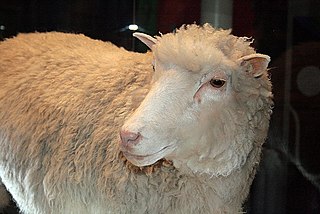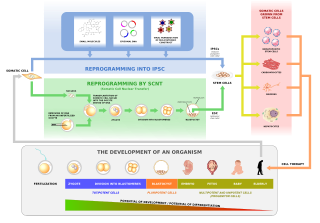Altered nuclear transfer is an alternative method of obtaining embryonic-like, pluripotent stem cells without the creation and destruction of human embryos. The process was originally proposed by William B. Hurlbut.

Dolly was a female Finn-Dorset sheep and the first mammal that was cloned from an adult somatic cell. She was cloned by associates of the Roslin Institute in Scotland, using the process of nuclear transfer from a cell taken from a mammary gland. Her cloning proved that a cloned organism could be produced from a mature cell from a specific body part. Contrary to popular belief, she was not the first animal to be cloned.

Gene therapy is a medical technology which aims to produce a therapeutic effect through the manipulation of gene expression or through altering the biological properties of living cells.

Human cloning is the creation of a genetically identical copy of a human. The term is generally used to refer to artificial human cloning, which is the reproduction of human cells and tissue. It does not refer to the natural conception and delivery of identical twins. The possibilities of human cloning have raised controversies. These ethical concerns have prompted several nations to pass laws regarding human cloning.

In multicellular organisms, stem cells are undifferentiated or partially differentiated cells that can differentiate into various types of cells and proliferate indefinitely to produce more of the same stem cell. They are the earliest type of cell in a cell lineage. They are found in both embryonic and adult organisms, but they have slightly different properties in each. They are usually distinguished from progenitor cells, which cannot divide indefinitely, and precursor or blast cells, which are usually committed to differentiating into one cell type.

In genetics and developmental biology, somatic cell nuclear transfer (SCNT) is a laboratory strategy for creating a viable embryo from a body cell and an egg cell. The technique consists of taking an denucleated oocyte and implanting a donor nucleus from a somatic (body) cell. It is used in both therapeutic and reproductive cloning. In 1996, Dolly the sheep became famous for being the first successful case of the reproductive cloning of a mammal. In January 2018, a team of scientists in Shanghai announced the successful cloning of two female crab-eating macaques from foetal nuclei.

Sir John Bertrand Gurdon is a British developmental biologist, best known for his pioneering research in nuclear transplantation and cloning.

Nuclear transfer is a form of cloning. The step involves removing the DNA from an oocyte, and injecting the nucleus which contains the DNA to be cloned. In rare instances, the newly constructed cell will divide normally, replicating the new DNA while remaining in a pluripotent state. If the cloned cells are placed in the uterus of a female mammal, a cloned organism develops to term in rare instances. This is how Dolly the Sheep and many other species were cloned. Cows are commonly cloned to select those that have the best milk production. On 24 January 2018, two monkey clones were reported to have been created with the technique for the first time.
Polly and Molly, two ewes, were the first mammals to have been successfully cloned from an adult somatic cell and to be transgenic animals at the same time. This is not to be confused with Dolly the Sheep, the first animal to be successfully cloned from an adult somatic cell where there wasn’t modification carried out on the adult donor nucleus. Polly and Molly, like Dolly the Sheep, were cloned at the Roslin Institute in Edinburgh, Scotland.
William B. Hurlbut is an Adjunct Professor in the Department of Neurobiology at Stanford University Medical Center. Born in 1945 in St. Helena, California, he grew up in Bronxville, New York.
Anaplasia is a condition of cells with poor cellular differentiation, losing the morphological characteristics of mature cells and their orientation with respect to each other and to endothelial cells. The term also refers to a group of morphological changes in a cell that point to a possible malignant transformation.
In biology, reprogramming refers to erasure and remodeling of epigenetic marks, such as DNA methylation, during mammalian development or in cell culture. Such control is also often associated with alternative covalent modifications of histones.

Robert Lanza is an American medical doctor and scientist, currently Head of Astellas Global Regenerative Medicine, and Chief Scientific Officer of the Astellas Institute for Regenerative Medicine. He is an Adjunct Professor at Wake Forest University School of Medicine.
SUNdomains are conserved C-terminal protein regions a few hundred amino acids long. SUN domains are usually found following a transmembrane domain and a less conserved region of amino acids. Most proteins containing SUN domains are thought to be involved in the positioning of the nucleus in the cell. It is thought that SUN domains interact directly with KASH domains in the space between the outer and inner nuclear membranes to bridge the nuclear envelope and transfer force from the nucleoskeleton to the cytoplasmic cytoskeleton which enables mechanosensory roles in cells. SUN proteins are thought to localize to the inner nuclear membrane. The S. pombe Sad1 protein localises at the spindle pole body. In mammals, the SUN domain is present in two proteins, Sun1 and Sun2. The SUN domain of Sun2 has been demonstrated to be in the periplasm.

U1 spliceosomal RNA is the small nuclear RNA (snRNA) component of U1 snRNP, an RNA-protein complex that combines with other snRNPs, unmodified pre-mRNA, and various other proteins to assemble a spliceosome, a large RNA-protein molecular complex upon which splicing of pre-mRNA occurs. Splicing, or the removal of introns, is a major aspect of post-transcriptional modification, and takes place only in the nucleus of eukaryotes.
Megan and Morag, two domestic sheep, were the first mammals to have been successfully cloned from differentiated cells. They are not to be confused with Dolly the sheep which was the first animal to be successfully cloned from an adult somatic cell or Polly the sheep which was the first cloned and transgenic animal. Megan and Morag, like Dolly and Polly, were cloned at the Roslin Institute in Edinburgh, Scotland in 1995.

Nuclear receptor TLX also known as NR2E1 is a protein that in humans is encoded by the NR2E1 gene. TLX is a member of the nuclear receptor family of intracellular transcription factors.

Homeobox protein CDX-2 is a protein that in humans is encoded by the CDX2 gene. The CDX2 protein is a homeobox transcription factor expressed in the nuclei of intestinal epithelial cells, playing an essential role in the development and function of the digestive system. CDX2 part of the ParaHox gene cluster, a group of three highly conserved developmental genes present in most vertebrate species. Together with CDX1 and CDX4, CDX2 is one of three caudal-related genes in the human genome.
Samuel H. Wood is a scientist and fertility specialist. In 2008, he became the first man to clone himself, donating his own DNA via somatic cell nuclear transfer (SCNT) to produce mature human embryos that were his clones.

Keith Henry Stockman Campbell was a British biologist who was a member of the team at Roslin Institute that in 1996 first cloned a mammal, a Finnish Dorset lamb named Dolly, from fully differentiated adult mammary cells. He was Professor of Animal Development at the University of Nottingham. In 2008, he received the Shaw Prize for Medicine and Life Sciences jointly with Ian Wilmut and Shinya Yamanaka for "their works on the cell differentiation in mammals".
Epstein–Barr nuclear antigen 1 (EBNA1) is a multifunctional, dimeric viral protein associated with Epstein–Barr virus (EBV). It is the only EBV protein found in all EBV-related malignancies. It is important in establishing and maintaining the altered state that cells take when infected with EBV. EBNA1 has a glycine–alanine repeat sequence that separates the protein into amino- and carboxy-terminal domains. This sequence also seems to stabilize the protein, preventing proteasomal breakdown, as well as impairing antigen processing and MHC class I-restricted antigen presentation. This thereby inhibits the CD8-restricted cytotoxic T cell response against virus-infected cells. EBNA1 is expressed from the Qp promoter during all latency programs. It is the only viral protein expressed in latency program I.